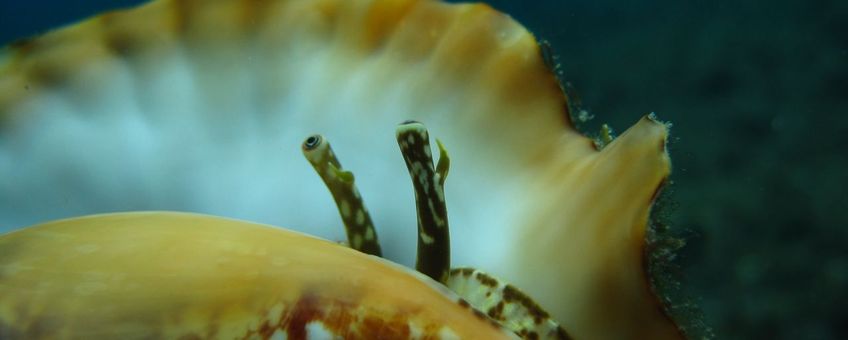
Exploring ways to reduce mortality of juvenile conches
Curaçao Sea Aquarium, Dutch Caribbean Nature Alliance (DCNA)The large marine gastropod queen conch (Strombus gigas) is a charismatic and iconic symbol of nature and one of the most important demersal fishery resources in the Caribbean region. Trade of the species (largely for consumption) is regulated by the CITES treaty, to which the Kingdom of the Netherlands is a party.

The Problem
Today, these iconic marine snails are threatened by over-exploitation and loss of shallow water habitats, throughout the Caribbean as well as in the ABC islands. Human activities have led to the degradation of nearshore conch habitats causing breeding failure, decreased growth and survival of juvenile conches. Excessively low densities mean that animals of breeding age fail to find mates and therefore also fail to breed. Queen conches are also particularly vulnerable to overfishing due to their unique life history (pelagic phase, density-dependent survival and reproduction; the so-called Allee Effect). The exploitation of queen conches throughout large parts of their natural range has led to population collapses and decrease in population densities to levels where mating success is diminished.
Hope on the Horizon
In 2020 the Queen Conch Hatchery Project was started at the Curaçao Sea Aquarium with Julia Ehrenheim as the key scientist. The science of hatchery production has been well established for many years but rewilding to bolster natural populations has consistently failed. Therefore, the main goal of this project is to find ways to reduce and/or eliminate high mortality rates that occur in early life stages and develop methods for effectively restocking of natural populations with hatchery-reared juvenile conches. In order to find answers to various elusive questions, Julia has started the research that she will use for her PhD degree at Wageningen University under Professors Tinka Murk and Dolfi Debrot.

The Experiments
Her first experiments aim to address the movement behavior of juvenile conches. For this she and her students tracked the activity of juvenile conches in a controlled hatchery environment. The results show that juvenile conches are more active at sunset than in the early morning or during midday. They also appear to preferentially move towards the current. Such experiments need to be done in the field but already suggest ways to facilitate the relocation of released hatchery conches and that juvenile conches will be most vulnerable to predators at sunset.
A second experiment showed that juvenile conches often aggregate together in the wild. Therefore, she studied if there was a beneficial density for growth. The first finding showed that juvenile conches grew the most in shell length with a density of 200 conches per square metre. Lower and higher population densities gave lower growth rates and lower total shell lengths, even though all were grown under the same conditions of food availability.
Correlations between weight and growth (in total length) indicate that there are distinct phases of growth. It seems that growth alternates between predominant growth in the thickness of the shell and in total shell length. Both do not occur simultaneously. The significance of this phenomenon to juvenile survival is not understood.


Implications
These findings for hatchery-reared conches will be further investigated and verified in wild grown juvenile conches. Taken together the results of this PhD project will help clarify why juvenile hatchery-released conches are so vulnerable and what needs to be done to enhance their survival so that they can be effectively used to restore natural populations.
DCNA
The Dutch Caribbean Nature Alliance (DCNA) supports science communication and outreach in the Dutch Caribbean region by making nature related scientific information more widely available through amongst others the Dutch Caribbean Biodiversity Database, DCNA’s news platform BioNews and the press. This article contains the results from several scientific studies but the studies themselves are not DCNA studies. No rights can be derived from the content. DCNA is not liable for the content and the in(direct) impacts resulting from publishing this article.
Text: Dutch Caribbean Nature Alliance (DCNA) and Julia Ehrenheim, Curaçao Sea Aquarium
Photos: Mark Vermeij; Julia Ehrenheim; Marion Haarsma
